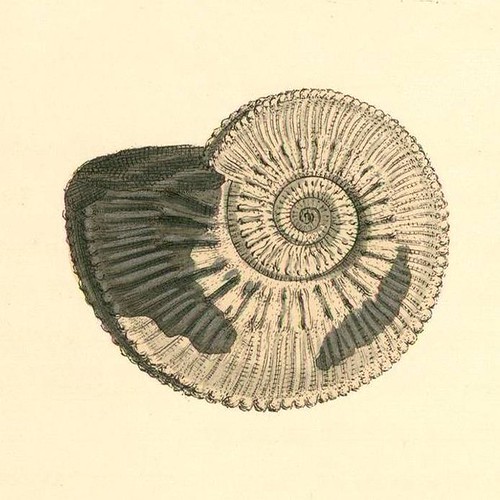


















The son of a lapidary, James Sowerby (1757-1822) studied art at the Royal Academy and came to be the patriarch over a family line of naturalist illustrators.
Sowerby obtained employment with the botanist William Curtis and contributed plates and hand colouring to 'The Botanical Magazine' and 'Flora Londinensis'. In 1790 he commenced the first of what would become a series of monumental projects with the production of some 2,500 plates over more than twenty years for Sir James Smith's 36 volume, 'English Botany'. By the end of the 18th century Sowerby was regarded as the leading British illustrator of botanical specimens.
Beyond plants, Sowerby applied his talents most significantly to extensive works on geology, mineralogy, mycology and, as with the fossil illustrations seen above, invertebrate palaeontology. [He also produced an innovative treatise on colour theory*]
There had been a rumour that much of Sowerby's hand-coloured engraving output was achieved with a production line. The story went that one of his three illustrator sons would apply a colour to the printed image and pass it over to his sibling for the next colour. They all did contribute to the publishing enterprises, each according to his abilities and age, but surviving records indicate that Sowerby laid down the background and left instructions for colourists, rather than there being a systematic approach in the workshop. Because many of Sowerby's publications were large multi-volume sets, the children (and other family members) became especially important in ensuring the later instalments were published after their father's death.
'Mineral Conchology of Great Britain, or Coloured Figures and Descriptions of those Remains of Testaceous Animals, or Shells which have been Preserved at Various Times, and Depths in the Earth' was issued in seven volumes between 1812 and 1846 which are online at the consistently wonderful University of Strasbourg. There are some 650 plates in the series and the above sampling was taken from across the volumes - all of the posted images (plus some more) were uploaded to this Webshots album.
- James Sowerby: His Publications and Collections.
- Wikipedia have a reasonably comprehensive article.
- Notes in relation to 'A New Elucidation of Colours, Original Prismatic and Material: Showing Their Concordance in the Three Primitives'.



















No comments :
Post a Comment
Comments are all moderated so don't waste your time spamming: they will never show up.
If you include ANY links that aren't pertinent to the blog post or discussion they will be deleted and a rash will break out in your underwear.
Also: please play the ball and not the person.
Note: only a member of this blog may post a comment.